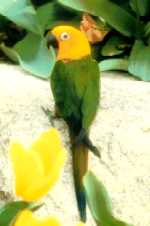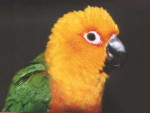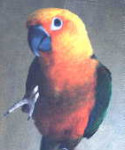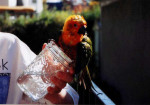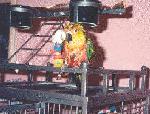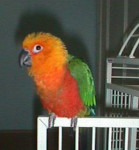Welcome to the
Jendaya Page!
|
Name: Chili Pepper |
Name: Stimpy |
Name: Cracker Jack |
|
Name: Brandy |
||
|
Name: |
Name: |
Name: |
Name: Jendaya Conure (Aratinga Jandaya)
Description: General plumage is green with the head and throat yellow, becoming orange on the upper breast. The front of the forehead and eye area are often red. Abdomen, flanks, and under wing-coverts are an orange-red. The edges of the feathers of the lower back are red and the outer webs of the primaries, primary-coverts, and secondaries are blue. The upperside of the tail is an olive-green with blue tips and the underside of the tail and flight-feathers are blackish. Periophthalmic Ring is whitish with the Iris being a greyish-brown. Their beak is black and their feet are grey. They are 30 cm (12 inches) in length. Immatures have a pale yellow head with scattered green feathers and a dark Iris. All Conures are not sexually dimorphic and must be DNA or surgically sexed.**
In The Wild: Usually observed singly, in pairs, or small groups of about 10 to 15 birds. Known for screeching especially when flying and often flies close to the ground making sudden changes in direction. Can be found in caatinga vegetation, savannah with trees, cleared areas, edges of rain forest, as well as coconut plantations.
Breeding Information: Breeding usually begins in February but winter breeding is also possible. A clutch consists of 3 to 5 eggs with an incubation period of 23 days and a fledging period of 50 days. Several breedings a year are possible. Eggs measure 28.4 x 22.6 mm (1.11 x 0.80 inches).
Temperament: Medium-noisy to noisy Conure. Usually noisy most often in the morning and early evening as well as when alarmed. Hardy and not difficult to keep. They are lively and inquisitive and are also hard chewers, so a supply of fresh branches is recommended. Like most Conures they also enjoy bathing.**
Diet: This should consist of Pellets, a good Seed Mix (Safflower, Oats, some Sunflower--also sprouted--Hemp, Wheat, Canary Grass Seed and various Millets), with various Fruits and Vegetables (apple, mango, cucumber, carrots, etc.) and Greens. White bread and eggfood biscuit for rearing. Diets may vary so you should consult your Avian Veterinarian.
�
* (Information Unavailable.)
** (Please note that not all birds are the same and may vary somewhat in Temperament and Plumage.)
